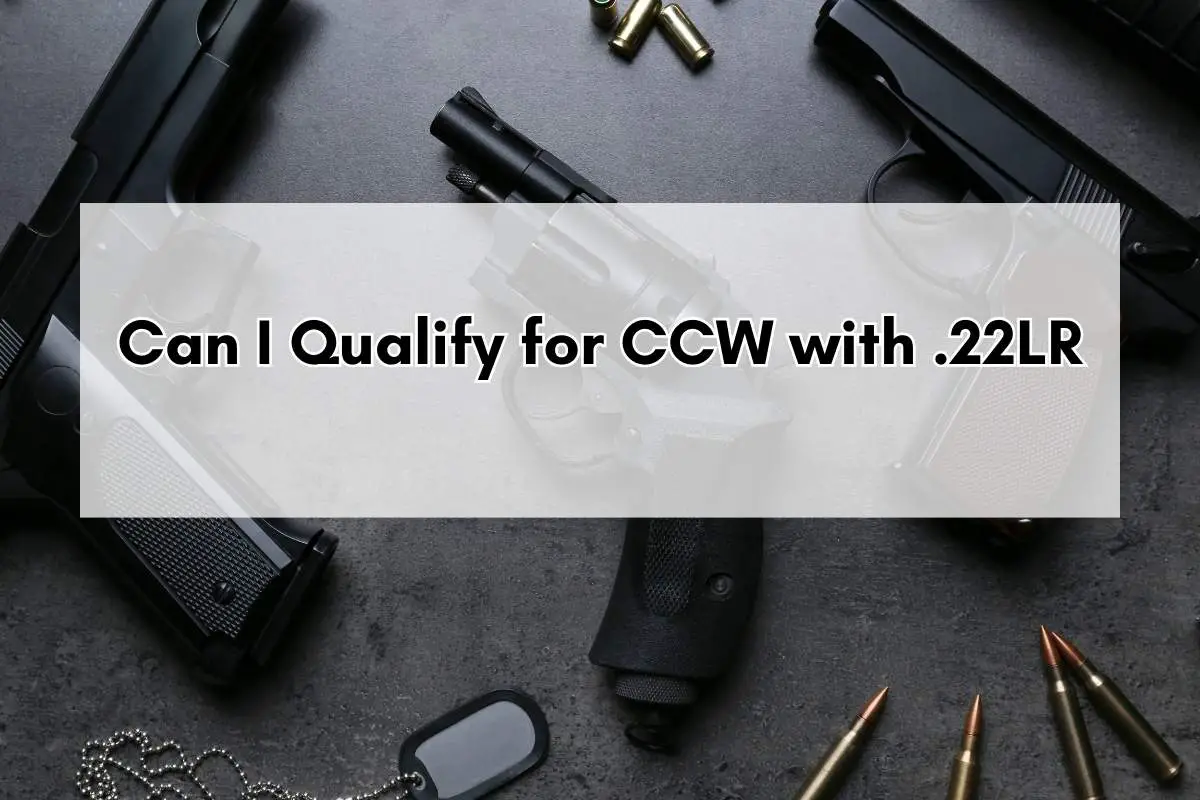Many people wonder if they can qualify for a concealed carry weapon (CCW) license using a .22LR firearm. The short answer is yes, in most cases. You can typically use a .22LR pistol for CCW qualification, as long as it meets the requirements set by your state and the specific class you’re taking.
Using a .22LR for CCW qualification has some benefits. These firearms are often easier for beginners to handle due to their low recoil. They’re also usually less expensive, making them a good choice for those on a budget. But it’s important to note that while you can qualify with a .22LR, you may want to consider a different caliber for actual self-defense situations.
Before signing up for a CCW class, check your state’s laws and the class requirements. Some states have specific rules about the type of firearm you can use. For example, in Illinois, you must qualify with the same caliber or higher than what you plan to carry. This means you can’t qualify with a .22LR and then carry a larger caliber.
Key Takeaways
- Most CCW classes allow the use of .22LR firearms for qualification.
- Check state laws and class requirements before using a .22LR for CCW qualification.
- Consider the practical aspects of using a .22LR for self-defense beyond just qualifying.
Understanding CCW Eligibility Requirements
Getting a concealed carry weapon (CCW) permit involves meeting specific criteria. These requirements vary across states but generally include age, residency, and legal considerations.
Federal Law Considerations
Federal law sets baseline rules for CCW eligibility. Applicants must be at least 21 years old in most cases. They can’t be felons, drug users, or have domestic violence convictions.
Mental health is another key factor. Those with certain mental health issues may be barred from getting a permit.
Citizenship or legal residency is typically required. Non-citizens might face extra hurdles in the application process.
State-Specific Criteria
States have their own CCW rules on top of federal laws. Some states are “shall-issue,” meaning they must give a permit if an applicant meets all criteria. Others are “may-issue,” giving officials more say in who gets a permit.
Training requirements differ by state. Many demand completion of a firearms safety course. The length and content of these courses vary widely.
Some states ask for a “good cause” to carry concealed. This might mean proving a specific threat or need for protection.
Background checks are standard. These look at criminal history and other factors that might disqualify an applicant.
Age and Residency Requirements
Most states set the minimum age for CCW at 21. A few allow 18-year-olds to apply, often with extra requirements.
Residency rules vary. Some states only give permits to their residents. Others offer non-resident permits, but these might have stricter criteria.
Proof of residency is usually needed. This could be a driver’s license, utility bill, or other official document.
Length of residency can matter. Some places require living in the state for a certain time before applying for CCW.
22LR Firearms and CCW Licensing
The 22LR caliber plays a unique role in concealed carry weapon (CCW) licensing. Its low recoil and cost make it popular, but questions arise about its effectiveness for self-defense and how it fits into CCW regulations.
Potential of 22LR for Self-Defense
22LR firearms have some advantages for self-defense. They’re easy to handle due to low recoil, allowing for quick follow-up shots. This can be helpful for shooters with limited strength or those sensitive to recoil.
These guns are often compact, making them suitable for concealed carry. The small size of 22LR ammunition also allows for higher capacity magazines.
However, 22LR has limitations. Its stopping power is less than larger calibers. This may impact its effectiveness in high-stress situations. Some experts argue that multiple well-placed 22LR shots can be effective, but others recommend larger calibers for self-defense.
Firearm Type and CCW Permitting
CCW licensing typically focuses on the act of carrying concealed rather than specific calibers. Most states don’t restrict the caliber for CCW permits. This means a 22LR pistol is often acceptable for CCW classes and licensing.
When applying for a CCW permit, applicants usually need to demonstrate proficiency with their chosen firearm. A 22LR can be advantageous here due to its low recoil and ease of use.
It’s crucial to check local laws, as some jurisdictions may have specific requirements. CCW licensing authorities can provide details on eligible firearm types and any caliber restrictions.
Application Process for CCW
Getting a CCW license involves several steps. Applicants must provide documentation, pass background checks, complete training, and submit their application correctly.
Documentation and Background Checks
To start the CCW application process, gather important documents. These usually include a valid ID, proof of residency, and fingerprints. County sheriffs and police departments handle CCW licensing, not the state DOJ.
Applicants must pass thorough background checks. These checks look at criminal history, mental health records, and other factors that might affect eligibility.
Some areas may ask for character references or a statement of good cause. Check local rules, as they can differ between counties and cities.
Training and Certification Requirements
CCW applicants must complete firearms training. The exact hours and content vary by location. Most programs cover gun safety, laws, and proper handling.
Training typically includes both classroom and shooting range time. Instructors teach legal responsibilities, conflict avoidance, and self-defense laws.
Applicants must show proficiency with their chosen carry weapon. This often means passing a shooting test. Keep certificates from approved training courses, as they’re needed for the application.
Submitting Your CCW Application
After gathering documents and completing training, it’s time to submit the application. Many departments now use online systems for initial submissions.
Fill out all forms carefully and accurately. Mistakes can delay the process. Be prepared for an interview with the licensing authority.
Fees are often required. These cover processing costs and may vary by location. After submission, patience is key. Processing times differ, but can take several weeks or months.
Legal Implications of Carrying a Concealed Weapon
Carrying a concealed weapon comes with important legal considerations. Laws vary by state, and violations can have serious consequences.
CCW Laws and Reciprocity Between States
CCW laws differ across states. Some require permits, while others allow permitless carry. It’s crucial to know the rules where you live and travel.
Reciprocity agreements let permit holders carry in other states. But not all states recognize each other’s permits. Check reciprocity maps before crossing state lines.
Some areas are off-limits even with a permit. These often include:
- Schools
- Government buildings
- Airports
- Private businesses with “no weapons” signs
Always research local laws before carrying. Ignorance isn’t a legal defense.
Liabilities and Legal Consequences of CCW Violations
Breaking CCW laws can lead to serious penalties. These may include:
- Fines
- Jail time
- Loss of gun rights
- Revocation of CCW permit
Even licensed carriers face restrictions. Carrying in prohibited places can result in charges.
Using a concealed weapon, even in self-defense, may have legal fallout. Be prepared for potential civil lawsuits or criminal charges.
CCW holders must follow strict rules on firearm use and storage. Negligence can lead to liability if the gun is misused or stolen.
Maintaining CCW Licensure
Keeping a concealed carry weapon (CCW) license valid requires ongoing effort and attention to legal requirements. License holders must stay informed about renewal deadlines and training obligations.
Renewal Processes
CCW licenses need renewal at set intervals. Most California counties require renewal every 2 years. The process often includes:
• Submitting a renewal application
• Paying a renewal fee
• Completing a background check
• Providing updated personal information
Some counties may ask for proof of residency or employment. It’s important to start the renewal process early. This helps avoid gaps in licensure.
Local issuing agencies handle renewals. They may have specific rules or extra steps. Check with your county sheriff or police department for details.
Continuing Education and Training
Many areas require ongoing training for CCW holders. This helps ensure they maintain their skills and knowledge.
Common training requirements include:
• Annual or biennial shooting qualifications
• Legal updates on self-defense and gun laws
• Safe gun handling and storage reviews
Some counties offer classes. Others accept training from certified instructors. Keep records of all completed courses.
Staying current with training is crucial. It helps CCW holders make safe, legal decisions. It also prepares them for license renewal.
CCW holders should check local rules often. Requirements can change. Staying informed helps maintain valid licensure.
Frequently Asked Questions
Carrying a .22 LR for concealed carry involves legal, practical, and equipment considerations. State laws, self-defense effectiveness, and suitable firearms all play a role in this decision.
What are the legal requirements for obtaining a CCW permit for a .22 LR firearm?
CCW permit requirements vary by state and local jurisdiction. Applicants typically need to meet age restrictions, pass background checks, and complete firearms training.
Some areas may have specific caliber requirements for CCW firearms. It’s crucial to check with local licensing authorities for exact rules.
How does a .22 caliber compare to other calibers for self-defense in terms of effectiveness?
The .22 LR is less powerful than larger calibers like 9mm or .45 ACP. It has lower stopping power and penetration.
Accuracy and shot placement become more critical with .22 LR for self-defense. Multiple shots may be necessary to stop a threat effectively.
What are the best .22 LR pistols recommended for concealed carry as of 2024?
Popular .22 LR pistols for concealed carry include the Ruger LCP II Lite Rack and Smith & Wesson M&P22 Compact. These models offer reliability and concealability.
Some shooters prefer .22 LR conversions for larger pistols, allowing practice with cheaper ammo while maintaining familiar ergonomics.
Are there specific considerations for carrying a .22 LR revolver, such as the Ruger LCR 22, for self-defense?
.22 LR revolvers like the Ruger LCR 22 offer simplicity and reliability. They’re easy to operate and less prone to malfunctions with rimfire ammunition.
Revolvers typically have lower capacity than semi-automatic pistols. This limitation should be considered for self-defense situations.
Can you elaborate on the features of optics-ready .22 LR pistols for concealed carry purposes?
Optics-ready .22 LR pistols allow for the mounting of red dot sights. This can improve target acquisition and accuracy, especially for those with vision issues.
Popular models include the Taurus TX22 Competition and Kel-Tec P17. These pistols offer increased sight radius and customization options.
What are the state-specific regulations regarding carrying a .22 LR as a CCW, for example, in California?
California CCW regulations apply to all calibers, including .22 LR. Permits are issued by county sheriffs or police chiefs.
Applicants must demonstrate “good cause” for carrying a concealed weapon. Training requirements and approved firearm lists may vary by issuing agency.

